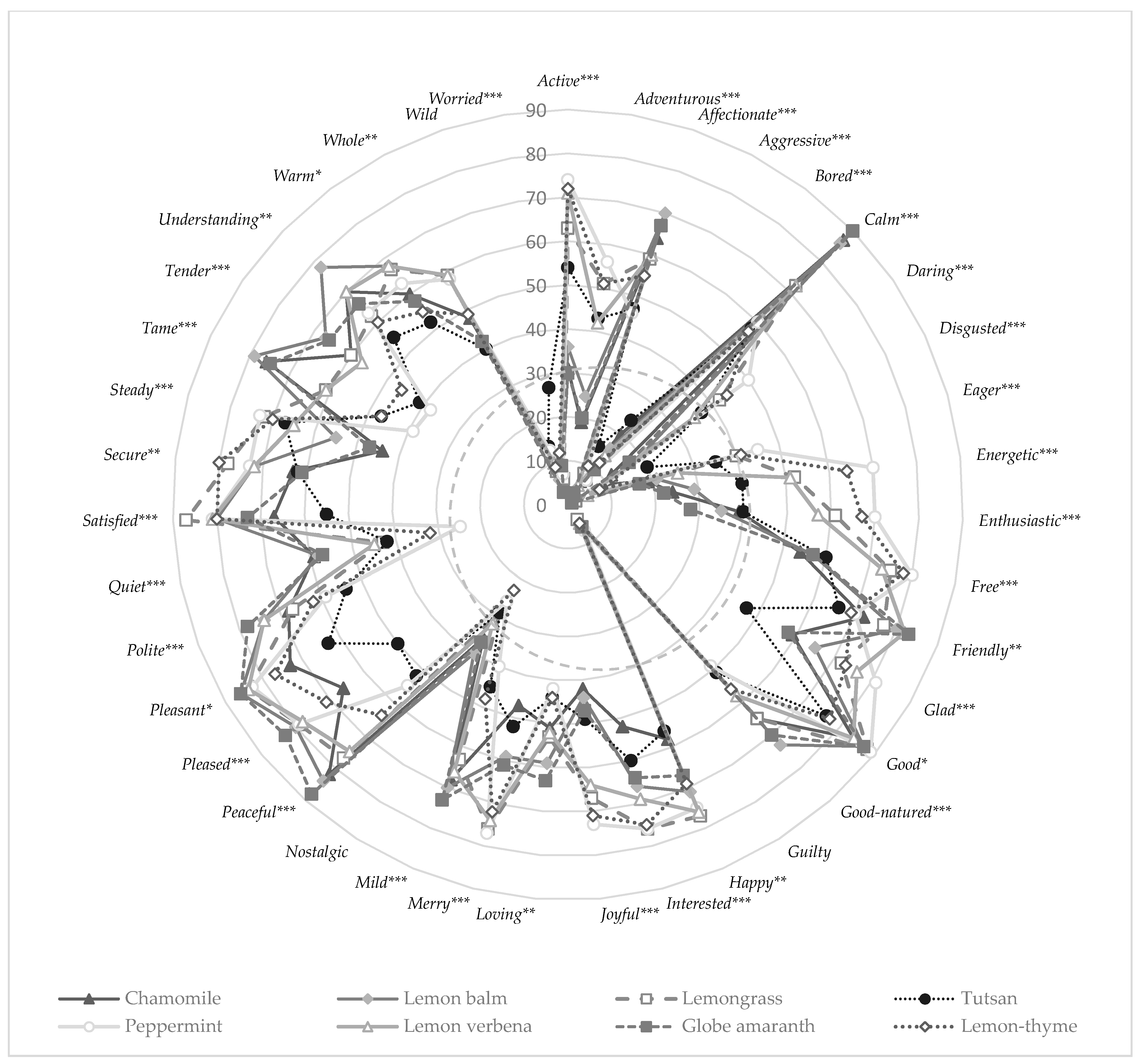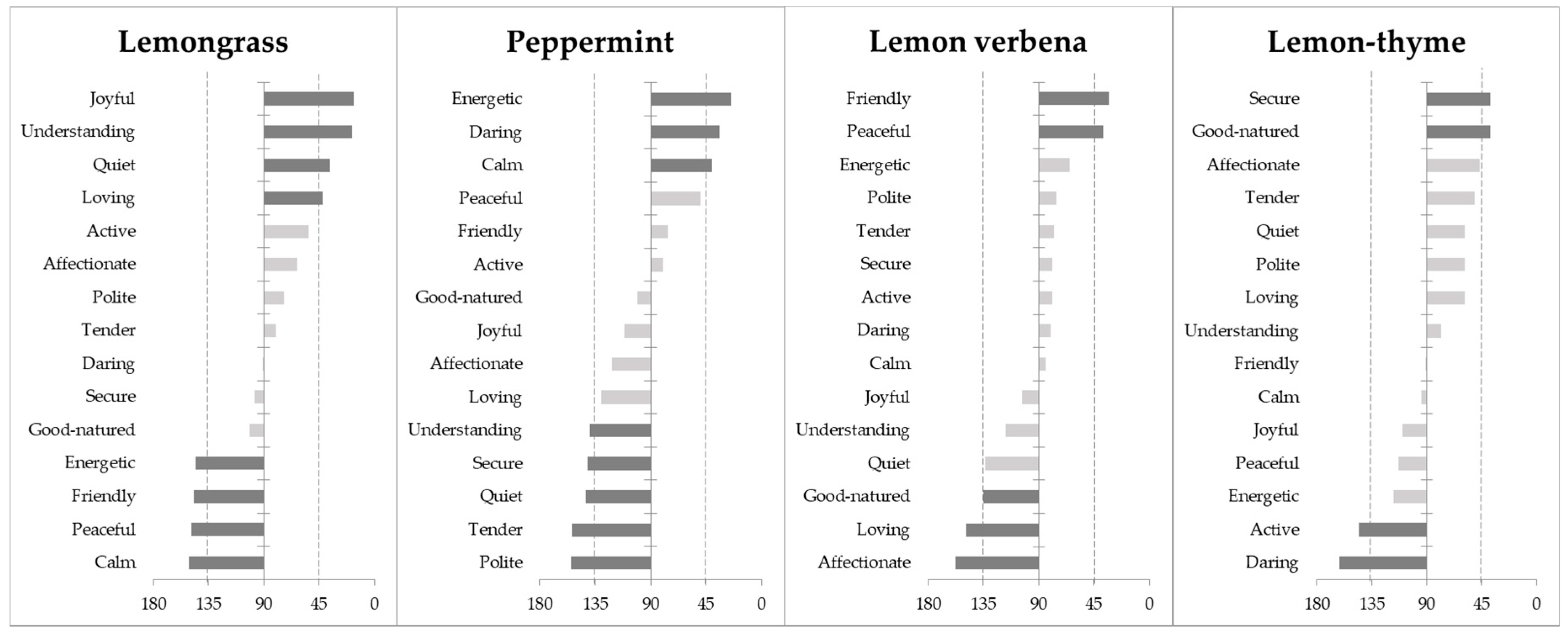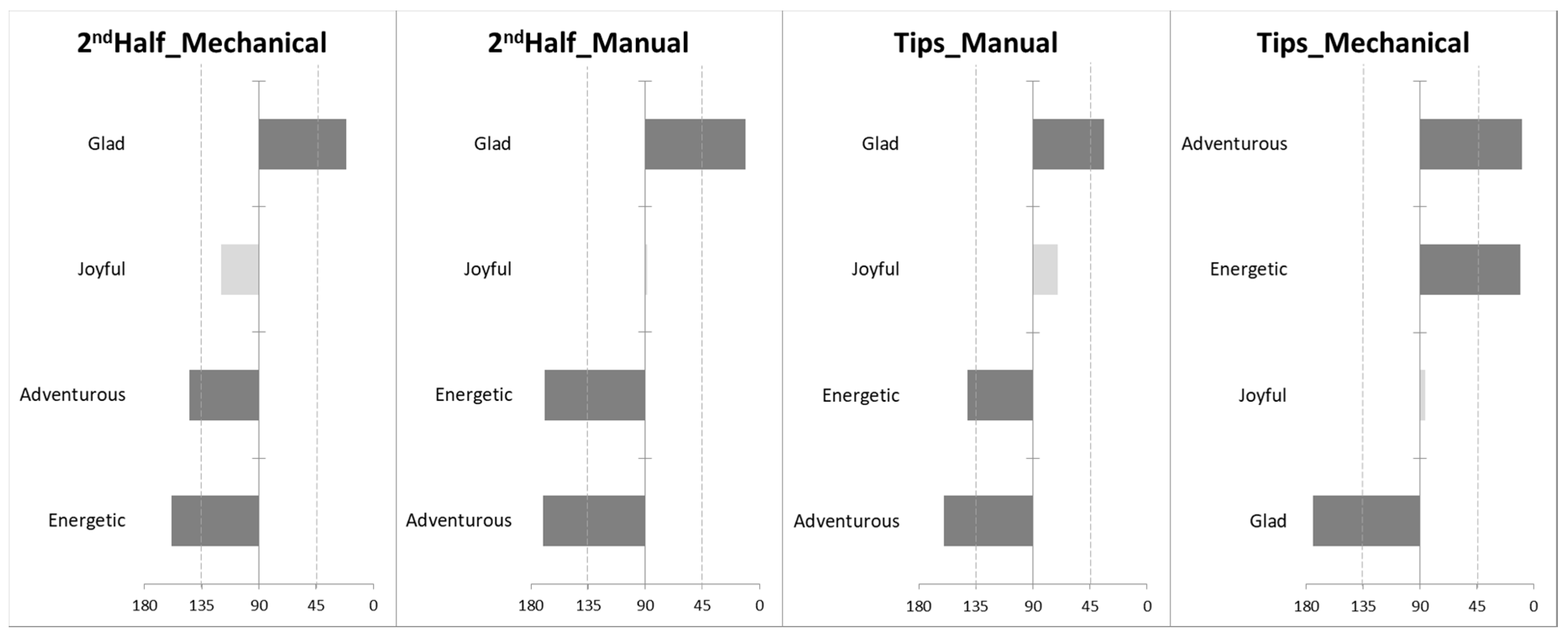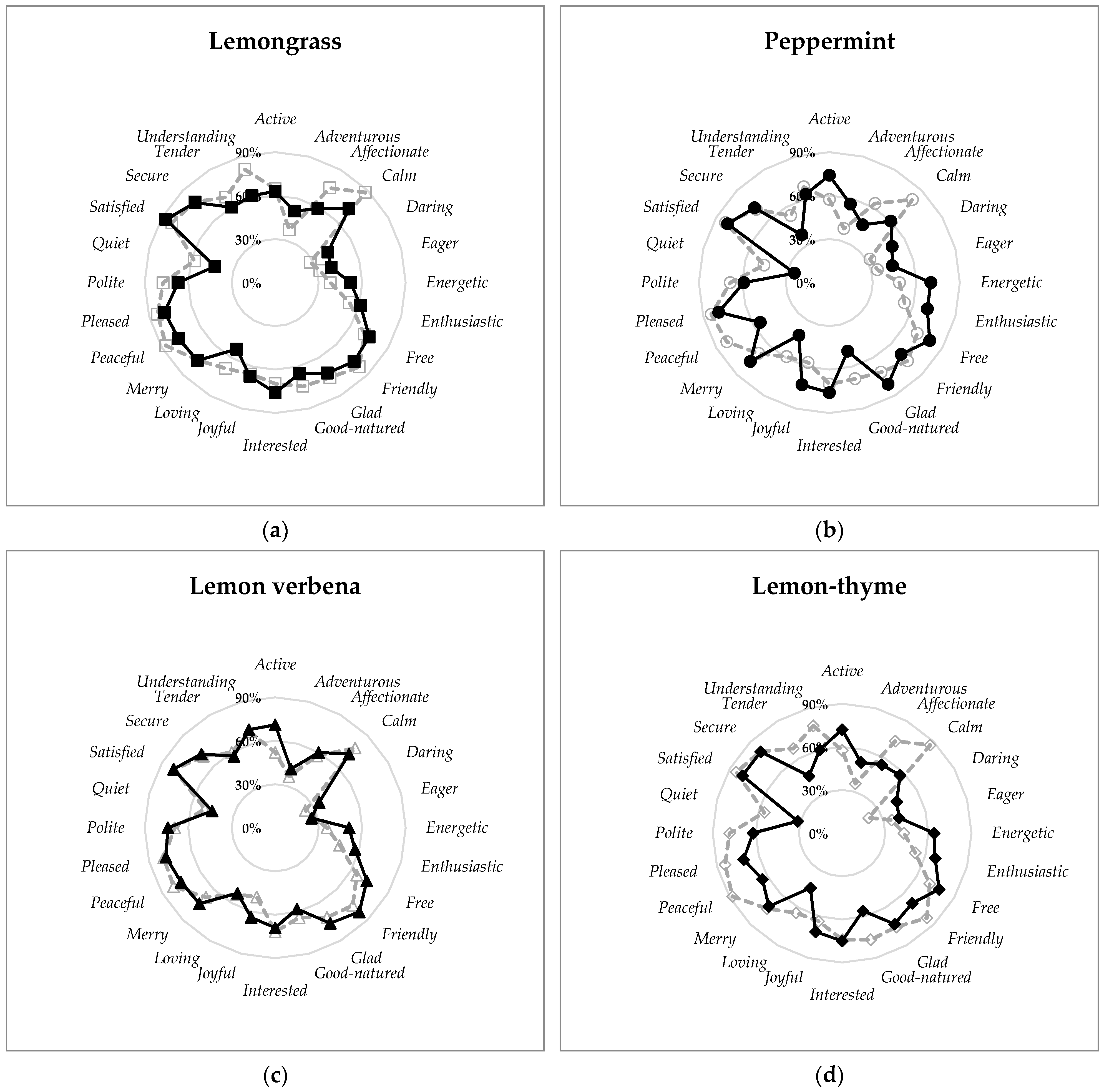Consumer-Led Adaptation of the EsSense Profile® for Herbal Infusions
Abstract
1. Introduction
2. Materials and Methods
2.1. Experimental Design
2.2. Experiment I: Pre-Selection of Terms from the EsSense Profile®
2.2.1. Samples
2.2.2. Sensory Panel
2.2.3. Ballot and Questionnaire Format
2.2.4. Focus Groups
2.2.5. Data Analysis
2.3. Experiment II: Evaluation of the Impact of Harvesting Conditions on the Elicited Emotional Profile
2.3.1. Samples
2.3.2. Sensory Evaluation
2.3.3. Data Analysis
3. Results
3.1. Pre-Selection of Terms from the EsSense Profile®
3.2. Evaluation of the Impact of Harvesting Conditions on Emotional Profile
3.2.1. Herbal Infusions Comparison
3.2.2. Comparison of the Samples Emotional Profile from the Original and the Adapted List
4. Discussion
5. Conclusions
Author Contributions
Funding
Institutional Review Board Statement
Informed Consent Statement
Data Availability Statement
Acknowledgments
Conflicts of Interest
References
- Koch, I.; Muller, M.; Joubert, E.; Van Der Rijst, M.; Næs, T. Sensory characterization of rooibos tea and the development of a rooibos sensory wheel and lexicon. Food Res. Int. 2012, 46, 217–228. [Google Scholar] [CrossRef]
- Sõukand, R.; Quave, C.L.; Pieroni, A.; Pardo-De-Santayana, M.; Tardío, J.; Kalle, R.; Łuczaj, Ł.; Svanberg, I.; Kolosova, V.; Aceituno-Mata, L.; et al. Plants used for making recreational tea in Europe: A review based on specific research sites. J. Ethnobiol. Ethnomed. 2013, 9, 58. [Google Scholar] [CrossRef]
- Kamiloglu, S.; Toydemir, G.; Boyacioglu, D.; Capanoglu, E. Health Perspectives on Herbal Tea Infusions. In Recent Progress in Medicinal Plants: Phytotherapeutics II; Govil, J.N., Pathak, M., Eds.; Studium Press LLC: Houston, TX, USA, 2016; Volume 43, pp. 353–368. [Google Scholar]
- Bach-Faig, A.; Berry, E.M.; Serra-Majem, L.; Lairon, D.; Reguant, J.; Trichopoulou, A.; Dernini, S.; Medina, F.X.; Battino, M.; Belahsen, R.; et al. Mediterranean diet pyramid today. Science and cultural updates. Public Health Nutr. 2011, 14, 2274–2284. [Google Scholar] [CrossRef]
- Schulzki, G.; Nüßlein, B.; Sievers, H. Transition rates of selected metals determined in various types of teas (Camellia sinensis L. Kuntze) and herbal/fruit infusions. Food Chem. 2017, 215, 22–30. [Google Scholar] [CrossRef] [PubMed]
- THIE. Tea and Herbal Infusions—Variety by Nature. Available online: http://www.thie-online.eu/about-thie/overview/ (accessed on 15 June 2017).
- King, S.C.; Meiselman, H.L.; Carr, B.T. Measuring emotions associated with foods in consumer testing. Food Qual. Prefer. 2010, 21, 1114–1116. [Google Scholar] [CrossRef]
- Ng, M.; Chaya, C.; Hort, J. Beyond liking: Comparing the measurement of emotional response using EsSense Profile and consumer defined check-all-that-apply methodologies. Food Qual. Prefer. 2013, 28, 193–205. [Google Scholar] [CrossRef]
- Jiang, Y.; King, J.; Prinyawiwatkul, W. A review of measurement and relationships between food, eating behavior and emotion. Trends Food Sci. Technol. 2014, 36, 15–28. [Google Scholar] [CrossRef]
- Cardello, A.V.; Jaeger, S.R. Measurement of Consumer Product Emotions Using Questionnaires. In Emotion Measurement; Elsevier BV: Amsterdam, The Netherlands, 2016; pp. 165–200. [Google Scholar]
- Jervis, M.; Drake, M. The Use of Qualitative Research Methods in Quantitative Science: A Review. J. Sens. Stud. 2014, 29, 234–247. [Google Scholar] [CrossRef]
- Van Kleef, E.; van Trijp, H.C.; Luning, P. Consumer research in the early stages of new product development: A critical review of methods and techniques. Food Qual. Prefer. 2005, 16, 181–201. [Google Scholar] [CrossRef]
- Chaya, C.; Eaton, C.; Hewson, L.; Vázquez, R.F.; Fernández-Ruiz, V.; Smart, K.A.; Hort, J. Developing a reduced con-sumer-led lexicon to measure emotional response to beer. Food Qual. Prefer. 2015, 45, 100–112. [Google Scholar] [CrossRef]
- Silva, A.P.; Jager, G.; Van Bommel, R.; Van Zyl, H.; Voss, H.-P.; Hogg, T.; Pintado, M.; De Graaf, C. Functional or emotional? How Dutch and Portuguese conceptualise beer, wine and non-alcoholic beer consumption. Food Qual. Prefer. 2016, 49, 54–65. [Google Scholar] [CrossRef]
- Laros, F.J.; Steenkamp, J.-B.E. Emotions in consumer behavior: A hierarchical approach. J. Bus. Res. 2005, 58, 1437–1445. [Google Scholar] [CrossRef]
- King, S.C.; Meiselman, H.L. Development of a method to measure consumer emotions associated with foods. Food Qual. Prefer. 2010, 21, 168–177. [Google Scholar] [CrossRef]
- Pineau, E.P.; Rytz, A.; Hudry, G.J.; Maier, A.; Alexander, E. Do different flavors generate different emotions? A multidis-ciplinary approach to measure the emotional response related to beverage consumption. In Proceedings of the Fourth European Conference on Sensory and Consumer Research: A Sense of Quality, Vitoria-Gasteiz, Spain, 5–8 September 2010; pp. 5–8. [Google Scholar]
- Ferrarini, R.; Carbognin, C.; Casarotti, E.; Nicolis, E.; Nencini, A.; Meneghini, A. The emotional response to wine consumption. Food Qual. Prefer. 2010, 21, 720–725. [Google Scholar] [CrossRef]
- Mora, M.; Giussani, B.; Pagliarini, E.; Chaya, C. Improvement of an emotional lexicon for the evaluation of beers. Food Qual. Prefer. 2019, 71, 158–162. [Google Scholar] [CrossRef]
- Rousset, S.; Deiss, V.; Juillard, E.; Schlich, P.; Droit-Volet, S. Emotions generated by meat and other food products in women. Br. J. Nutr. 2005, 94, 609–619. [Google Scholar] [CrossRef]
- Thomson, D.M.; Crocker, C. A data-driven classification of feelings. Food Qual. Prefer. 2013, 27, 137–152. [Google Scholar] [CrossRef]
- Chrea, C.; Grandjean, D.; Delplanque, S.; Cayeux, I.; Le Calvé, B.; Aymard, L.; Velazco, M.I.; Sander, D.; Scherer, K.R. Mapping the semantic space for the subjective experience of emotional responses to odors. Chem. Senses 2009, 34, 49–62. [Google Scholar] [CrossRef] [PubMed]
- Desmet, P.M.; Schifferstein, H.N. Sources of positive and negative emotions in food experience. Appetite 2008, 50, 290–301. [Google Scholar] [CrossRef] [PubMed]
- King, S.C.; Meiselman, H.L.; Carr, B.T. Measuring emotions associated with foods: Important elements of questionnaire and test design. Food Qual. Prefer. 2013, 28, 8–16. [Google Scholar] [CrossRef]
- Cardello, A.V.; Meiselman, H.L.; Schutz, H.G.; Craig, C.; Given, Z.; Lesher, L.L.; Eicher, S. Measuring emotional responses to foods and food names using questionnaires. Food Qual. Prefer. 2012, 24, 243–250. [Google Scholar] [CrossRef]
- Jaeger, S.R.; Cardello, A.V.; Schutz, H.G. Emotion questionnaires: A consumer-centric perspective. Food Qual. Prefer. 2013, 30, 229–241. [Google Scholar] [CrossRef]
- Spinelli, S.; Masi, C.; Dinnella, C.; Zoboli, G.P.; Monteleone, E. How does it make you feel? A new approach to measuring emotions in food product experience. Food Qual. Prefer. 2014, 37, 109–122. [Google Scholar] [CrossRef]
- Manzocco, L.; Rumignani, A.; Lagazio, C. Emotional response to fruit salads with different visual quality. Food Qual. Prefer. 2013, 28, 17–22. [Google Scholar] [CrossRef]
- Nestrud, M.A.; Meiselman, H.L.; King, S.C.; Lesher, L.L.; Cardello, A.V. Development of EsSense25, a shorter version of the EsSense Profile®. Food Qual. Prefer. 2016, 48, 107–117. [Google Scholar] [CrossRef]
- Meiselman, H.L. A review of the current state of emotion research in product development. Food Res. Int. 2015, 76, 192–199. [Google Scholar] [CrossRef]
- Ogarkova, A. Translatability of emotions. In Emotion Measurement; Meiselman, H.L., Ed.; Woodhead Publishing Elsevier: Amsterdam, The Netherlands, 2016; pp. 575–599. [Google Scholar]
- Jaeger, S.R.; Cardello, A.V. Methodological Issues in Consumer Product Emotion Research Using Questionnaires. Emot. Meas. 2016, 323–358. [Google Scholar] [CrossRef]
- Adams, J.; Williams, A.; Lancaster, B.; Foley, M. Advantages and uses of check-all-that-apply response compared to tra-ditional scaling of attributes for salty snacks. In Proceedings of the 7th Pangborn Sensory Science Symposium, Minneapolis, MN, USA, 12–16 August 2007; p. 16. [Google Scholar]
- Jaeger, S.R.; Swaney-Stueve, M.; Chheang, S.L.; Hunter, D.C.; Pineau, B.; Ares, G. An assessment of the CATA-variant of the EsSense Profile®. Food Qual. Prefer. 2018, 68, 360–370. [Google Scholar] [CrossRef]
- Cunha, L.M.; Moura, A.P.; Lima, R.C.; Souza-Filho, A.; Silva, T.N.; Pedrozo, E.A. Emotional profile and acceptability of Brazilian nuts (Bertholletia excelsa): Evaluation and comparison with more familiar nuts. In Proceedings of the Sixth European Conference on Sensory and Consumer Research (EUROSENSE), Copenhagen, Denmark, 7–10 September 2014. [Google Scholar]
- Cardoso, L. Sensory Evaluation of Infusions of Aromatic and Medicinal Plants: Influence of Post-Harvest Factors and Preparation Process. MSc Thesis, University of Porto, Porto, Portugal, 2013. [Google Scholar]
- Rocha, C.; Madeira, A.; Lima, R.C.; Cardoso, L.; Alves, L.; Cunha, L.M. Optimization of processing conditions for improved sensory acceptance of herbal teas: Effect of time and temperature. In Proceedings of the 9th International Conference on Cul-inary Arts and Sciences, Montclair State University, NJ, USA, 3—5 June 2015. [Google Scholar]
- Rocha, C.; Coelho, M.; Lima, R.C.; Campos, F.M.; Pintado, M.; Cunha, L.M. Increasing phenolic and aromatic compounds extraction and maximizing liking of lemon verbena (Aloysia triphylla) infusions through the optimization of steeping temperature and time. Food Sci. Technol. Int. 2019, 25, 701–710. [Google Scholar] [CrossRef]
- Jaeger, S.R.; Cadena, R.S.; Torres-Moreno, M.; Antúnez, L.; Vidal, L.; Giménez, A.; Hunter, D.C.; Beresford, M.K.; Kam, K.; Yin, D.; et al. Comparison of check-all-that-apply and forced-choice Yes/No question formats for sensory characterisation. Food Qual. Prefer. 2014, 35, 32–40. [Google Scholar] [CrossRef]
- MacFie, H.J.; Bratchell, N.; Greenhoff, K.; Vallis, L.V. Designs to balance the effect of order of presentation and first-order carry-over effects in hall tests. J. Sens. Stud. 1989, 4, 129–148. [Google Scholar] [CrossRef]
- Bloor, M.; Frankland, J.; Thomas, M.; Robson, K. Focus Groups in Social Research; SAGE Publications: Thousand Oaks, CA, USA, 2001. [Google Scholar]
- Guerrero, L.; Xicola, J. Chapter 3—New Approaches to Focus Groups. In Methods in Consumer Research; Ares, G., Varela, P., Eds.; Woodhead Publishing: Cambridge, UK, 2018; Volume 1, pp. 49–77. [Google Scholar] [CrossRef]
- Hollander, M.; Wolfe, D.A.; Chicken, E. Nonparametric Statistical Methods; John Wiley & Sons: Hoboken, NJ, USA, 2013. [Google Scholar]
- Bardin, L. L’analyse de Contenu; Presses Universitaires de France Paris: France, Paris, 1977; Volume 69. [Google Scholar]
- Addinsoft. XLSTAT Statistical and Data Analysis Solution; Addinsoft: Paris, France, 2019; Available online: https://www.xlstat.com (accessed on 10 January 2020).
- IBMCorp. IBM SPSS Statistics for Windows, Version 26.0; IBM Corp: Armonk, NY, USA, 2019; Available online: https://www.ibm.com/analytics/spss-statistics-software (accessed on 10 January 2020).
- Varela, P.; Ares, G. Sensory profiling, the blurred line between sensory and consumer science. A review of novel methods for product characterization. Food Res. Int. 2012, 48, 893–908. [Google Scholar] [CrossRef]
- Ares, G.; Barreiro, C.; Deliza, R.; Giménez, A.; Gámbaro, A. Application of a check-all-that-apply question to the development of chocolate milk desserts. J. Sens. Stud. 2010, 25, 67–86. [Google Scholar] [CrossRef]
- Meyners, M.; Castura, J.C.; Carr, B.T. Existing and new approaches for the analysis of CATA data. Food Qual. Prefer. 2013, 30, 309–319. [Google Scholar] [CrossRef]
- Cunha, L.M. Translation of emotion terms from English to Portuguese and backwards- EsSense Profile and beyond. In Proceedings of the Sixth European Conference on Sensory and Consumer Research (EUROSENSE 2014), Bella Center, Copenhagen, Denmark, 7–10 September 2014. [Google Scholar]
- Bhumiratana, N.; Adhikari, K.; Chambers, E. The development of an emotion lexicon for the coffee drinking experience. Food Res. Int. 2014, 61, 83–92. [Google Scholar] [CrossRef]
- Talavera, M.; Sasse, A.M. Gathering consumer terminology using focus groups—An example with beauty care. J. Sens. Stud. 2019, 34, 12533. [Google Scholar] [CrossRef]
- Li, W.; Nachtsheim, C.J.; Wang, K.; Reul, R.; Albrecht, M. Conjoint Analysis and Discrete Choice Experiments for Quality Improvement. J. Qual. Technol. 2013, 45, 74–99. [Google Scholar] [CrossRef]
- Johnson, F.R.; Lancsar, E.; Marshall, D.; Kilambi, V.; Muhlbacher, A.; Regier, D.A.; Bresnahan, B.W.; Kanninen, B.; Bridges, J.F.P. Constructing Experimental Designs for Discrete-Choice Experiments: Report of the ISPOR Conjoint Analysis Ex-perimental Design Good Research Practices Task Force. Value Health 2013, 16, 3–13. [Google Scholar] [CrossRef]
- Ribeiro, L.; Moura, A.P.d.; Cunha, L.M. Integrated approach to the consumption of herbal teas: An exploratory study based on visual ethnography and behavioural questionnaires approach. In Proceedings of the ICCAS 2017, 10th International Conference on Culinary Arts and Science: Exploring Future Foodscapes: Proceedings, Copenhagen, Denmark, 6–7 July 2017; pp. 151–160. [Google Scholar]
- Moura, I.; Fonseca, S.C.; Carvalho, S.; Cunha, L.M. Consumer perception of hydroponic-cultivated lettuce marketed with root. In Proceedings of the 8th European Conference on Sensory and Consumer Research ‘A Sense of Taste’ (EuroSense 2018), Verona, Italy, 2–5 September 2018. [Google Scholar]
- Kuesten, C.; Chopra, P.; Bi, J.; Meiselman, H.L. A global study using PANAS (PA and NA) scales to measure consumer emotions associated with aromas of phytonutrient supplements. Food Qual. Prefer. 2014, 33, 86–97. [Google Scholar] [CrossRef]
- Rocha, C.; Lima, R.; Moura, A.; Costa, T.; Cunha, L. Implicit evaluation of the emotional response to premium organic herbal infusions through a temporal dominance approach: Development of the temporal dominance of facial emotions (TDFE). Food Qual. Prefer. 2019, 76, 71–80. [Google Scholar] [CrossRef]





| Sample | Temperature (°C) | Time (Minutes) |
|---|---|---|
| Lemon balm (Melissa officinalis) 1 | 85 | 5.0 |
| Chamomile (Chamomilla recutita) 1 | 90 | 5.0 |
| Globe amaranth (Gomphrena globose) 1 | 90 | 10.0 |
| Tutsan (Hypericum androsaemum) 1 | 85 | 7.0 |
| Lemongrass (Cymbopogon citratus) 2 | 99 | 8.5 |
| Lemon verbena (Aloysia triphylla) 3 | 96 | 6.0 |
| Peppermint (Mentha x piperita) 2 | 95 | 4.0 |
| Lemon thyme (Thymus x citriodorus) 2 | 92 | 7.0 |
| Infusion | Overall Liking 1 Mean (±SD) |
|---|---|
| Peppermint (Mentha x piperita) | 7.9 (±1.3) a |
| Lemongrass (Cymbopogon citratus) | 7.8 (±1.3) a |
| Lemon verbena (Aloysia triphylla) | 7.7 (±1.5) a |
| Lemon thyme (Thymus x citriodorus) | 7.5 (±1.7) a |
| Lemon balm (Melissa officinalis) | 7.5 (±1.4) a |
| Globe amaranth (Gomphrena globose) | 7.0 (±1.3) b |
| Chamomile (Chamomilla recutita) | 6.9 (±1.7) b |
| Tutsan (Hypericum androsaemum) | 6.4 (±1.8) c |
| Kept Emotion Terms—EN (PT) | Removed Emotion Terms—EN (PT) | |
|---|---|---|
| Active (Ativo(a)) | Interested (Interessado(a)) | Aggressive (Agressivo(a)) |
| Adventurous (Aventureiro(a)) | Joyful (Jovial) | Bored (Aborrecido(a)) |
| Affectionate (Carinhoso(a)) | Loving (Amoroso(a)) | Disgusted (Enojado(a)) |
| Calm (Calmo(a)) | Merry (Alegre) | Good (Bem) |
| Daring (Ousado(a)) | Peaceful (Em paz) | Guilty (Culpado(a)) |
| Eager (Ávido(a)) | Pleased (Agradado(a)) | Happy (Feliz) |
| Energetic (Energético(a)) | Polite (Amável) | Mild (Meigo(a)) |
| Enthusiastic (Entusiasmado(a)) | Quiet (Quieto(a)) | Nostalgic (Nostálgico(a)) |
| Free (Livre) | Satisfied (Satisfeito(a)) | Pleasant (Agradável) |
| Friendly (Amigável) | Secure (Seguro(a)) | Steady (Firme) |
| Glad (Contente) | Tender (Terno(a)) | Tame (Dócil) |
| Good-natured (Bondoso(a)) | Understanding (Compreensivo(a)) | Warm (Caloroso(a)) |
| Whole (Completo(a)) | ||
| Wild (Descontrolado(a)) | ||
| Worried (Preocupado(a)) | ||
| Herbal Infusions | Treatment | Treatment Overall Liking 1 Mean a (±SD) | Infusion Overall Liking 1 Mean (±SD) |
|---|---|---|---|
| Lemongrass | 2nd Half—Manual | 7.6 (±1.0) | 7.7 (±0.9) |
| 2nd Half—Mechanical | 7.8 (±0.8) | ||
| Tips—Manual | 7.8 (±0.9) | ||
| Tips—Mechanical | 7.7 (±1.0) | ||
| Peppermint | 2nd Half—Manual | 7.5 (±1.4) | 7.6 (±1.2) |
| 2nd Half—Mechanical | 7.6 (±1.2) | ||
| Tips—Manual | 7.7 (±1.3) | ||
| Tips—Mechanical | 7.6 (±1.0) | ||
| Lemon verbena | 2nd Half—Manual | 7.8 (±1.0) | 7.7 (±1.0) |
| 2nd Half—Mechanical | 7.6 (±1.2) | ||
| Tips—Manual | 7.7 (±0.9) | ||
| Tips—Mechanical | 7.6 (±1.1) | ||
| Lemon thyme | 2nd Half—Manual | 7.5 (±0.9) | 7.5 (±0.9) |
| 2nd Half—Mechanical | 7.5 (±0.9) | ||
| Tips—Manual | 7.6 (±0.8) | ||
| Tips—Mechanical | 7.4 (±1.0) |
Publisher’s Note: MDPI stays neutral with regard to jurisdictional claims in published maps and institutional affiliations. |
© 2021 by the authors. Licensee MDPI, Basel, Switzerland. This article is an open access article distributed under the terms and conditions of the Creative Commons Attribution (CC BY) license (http://creativecommons.org/licenses/by/4.0/).
Share and Cite
Rocha, C.; Pinto Moura, A.; Pereira, D.; Costa Lima, R.; Cunha, L.M. Consumer-Led Adaptation of the EsSense Profile® for Herbal Infusions. Foods 2021, 10, 684. https://doi.org/10.3390/foods10030684
Rocha C, Pinto Moura A, Pereira D, Costa Lima R, Cunha LM. Consumer-Led Adaptation of the EsSense Profile® for Herbal Infusions. Foods. 2021; 10(3):684. https://doi.org/10.3390/foods10030684
Chicago/Turabian StyleRocha, Célia, Ana Pinto Moura, Diana Pereira, Rui Costa Lima, and Luís Miguel Cunha. 2021. "Consumer-Led Adaptation of the EsSense Profile® for Herbal Infusions" Foods 10, no. 3: 684. https://doi.org/10.3390/foods10030684
APA StyleRocha, C., Pinto Moura, A., Pereira, D., Costa Lima, R., & Cunha, L. M. (2021). Consumer-Led Adaptation of the EsSense Profile® for Herbal Infusions. Foods, 10(3), 684. https://doi.org/10.3390/foods10030684








